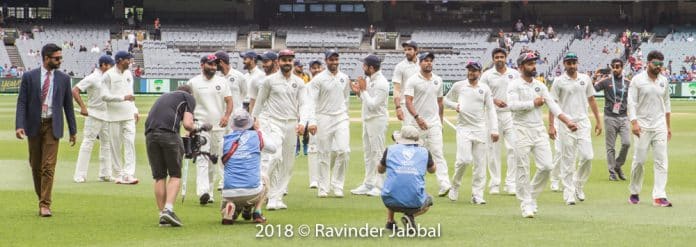India’s journey to win its first Test series on Australian soil began 12 months ago, when Kohli’s team lost 2-1 against a South African side featuring the now-retired AB de Villiers and Morne Morkel. The tourists’ only victory came in the dead rubber in Johannesburg, albeit on the most difficult of the three pitches served up to the visitors. In that win, both Mohammad Shami and Jasprit Bumrah took 5-wicket hauls. It was the first sign that India’s exciting crop of fast bowlers were finally up to the challenge of bowling India to victories in foreign conditions, even where their batsmen failed to provide any advantage.
Fast forward 12 months, and India fields teams in Melbourne and Sydney that retain only 5 or 6 players from its successful Johannesburg XI. In years gone by – and indeed for most teams today – that would be a sign of chaos, of instability. Yet for this Indian side, it means one thing: depth. And more so than the indefatigable Pujara, the explosive Bumrah or mastermind Kohli, depth is what eventually wins India their first series in Australia.
It was a lack of depth, conversely, that ended Australia’s ambitions of defending history, but the scale of the problem was not clear until the fat lady had sung and Kohli was lifting the trophy. Even when it was announced after the Cape Town ball-tampering scandal that Australia would be without Steve Smith and David Warner for the home summer, it was not seen as a completely fatal blow.
After all, Australia as a team have never been reliant on one or two players; Australia is the land of a first-class competition that has been the envy of the world, an endless treasure chest of fast bowlers and aggressive batsmen who thrive on flat and hard pitches. This is the country where a player as good as Matthew Hayden had to spend several seasons averaging above 50 in the strongest-ever Australian domestic cricket competition before being given an extended run in the national side.
And in the first two matches of this series, it seemed as though that vision would hold true. On the very first day in Adelaide, the Indian top order was dismantled, as the tourists slumped to 5/86 shortly after lunch, then limped to 250 courtesy of a lone hand by Pujara. Then, even as stalwarts like Khawaja and Marsh failed to deliver in the hosts’ first innings, new blood in Travis Head, Peter Handscomb and Marcus Harris all contributed to bring Australia within touching distance of India. Australia ran close in the end, but lost by 31 runs on a pitch that was always widely regarded to be India’s best chance at winning a match.
In Perth, normal Australian service seemed to have resumed as the Indian batsmen twice succumbed to relentless pressure on a diabolical but excellent pitch. It was not the usual Australian blueprint of success, but it was effective. In fact, without Kohli’s sublime first innings century, the margin may have been humiliating for India, as have been many of its losses in Australia.
But it is funny how long a few weeks can be in cricket; that lofty image of Australian cricket now seems like a distant mirage in the rear-view mirror.
In Melbourne, reeling from the ignominy of the loss in Perth, India replace both their failing openers. It is an almost unheard-of decision in the middle of a tour like this, especially with the series tied 1-1. The local papers report that the Indians are panicking, but the panic button works; debutant Mayank Agarwal is the most assured of all the Indian batsmen, posting a fluent 76 in the first innings, and 42 in the second innings as the rest of the team collapsed around him. The promoted Hanuma Vihari blunts the new ball effectively, scoring 8 off 66 in an innings that Kohli praises as equally important as Pujara’s marathon century. The other replacement, Jadeja, takes 5 wickets from 57 tight overs on an unresponsive pitch as India retain the Border-Gavaskar Trophy.
India rubs salt in the wounds in Sydney as the hosts crumble, their bowlers now on their knees. Again, Agarwal and Vihari impress, and Pujara continues Pujara-ing. Rishabh Pant (159*) slams the highest-ever score by a visiting wicketkeeper at the SCG, in the company of Ravindra Jadeja who scores a blistering 81. Then Rohit Sharma’s replacement, Kuldeep Yadav, takes 5-99, the hosts capitulating and following-on before the Sydney weather invokes the mercy rule.
Even still, some have questioned whether an Indian side without Pujara and Kohli would beat Australia.
The answer is that, in home conditions, India could actually lose most of its top 6 batsmen, including Pujara and Kohli, and still comfortably beat an Australian side with Warner and Smith. With batsmen such as Karun Nair, Prithvi Shaw, Shreyas Iyer and Shubman Gill waiting in the wings, along with the more experienced hands who did not feature in the most recent Tests such as Rohit Sharma, KL Rahul and Murali Vijay, India’s batting riches know few bounds. Even the loss of one of its all-time great spinners in Ravi Ashwin did not hurt India’s cause, as Yadav and Jadeja proved. All of these players could walk into the Australian XI today.
The upshot of it all? There is no doubt that India’s series win is historic, but it is also an unqualified one; there will be no asterisk next to this achievement, as much as some may desire it.
Photo: Ravinder Singh Jabbal




